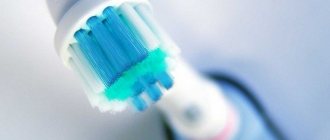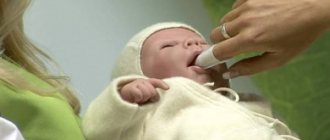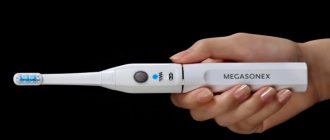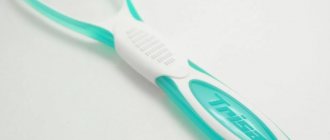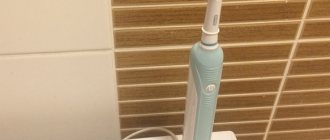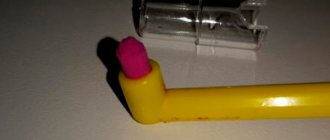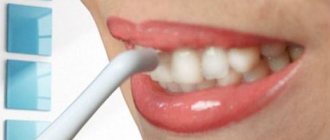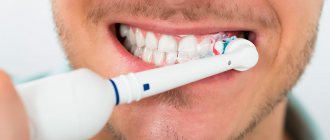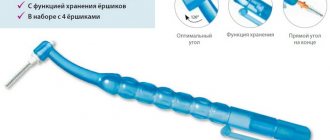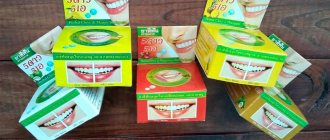Many people buy toothbrushes without thinking about their technical characteristics and based only on price. However, they differ in many parameters: the material and stiffness of the bristles, the shape and size of the head, etc. To choose the right toothbrush, you should take into account as many criteria as possible. Let's tell you more about them.
In this article
- Which toothbrush to choose
- What shape and size should a toothbrush be?
- How to choose a toothbrush based on bristle material
- What toothbrush is best?
- Which toothbrush to choose - soft or hard?
- How to choose a brush based on the shape of the bristles
- Additional functions of toothbrushes
- Hardness of electric toothbrushes
- Which toothbrush to buy
- How often to change the brush
- How to care for your brush
When buying a toothbrush, do we think about the stiffness of the bristles, the size of the head, the material and its other parameters? As a rule, we choose them based on external data, based on the fact that one model is suitable for adults, the other for children. However, the quality of cleaning the oral cavity depends on a properly selected toothbrush. If it is not suitable for medical parameters and individual anatomical features, it cannot be used, as there is a risk of damage to the gums and enamel. In addition, brushing your teeth with such a brush will simply be inconvenient.
Understanding this issue is not so difficult. There are several criteria that will help you choose the right toothbrush.
What shape and size should a toothbrush be?
Toothbrushes are available in different sizes and head shapes. Please note the following features:
- The head should cover a maximum of 2-2.5 teeth. Only in this case will cleaning be effective. The head is too large and does not allow the bristles to penetrate into the interdental spaces.
- The length of the toothbrush head for children should be 18-25 mm, and for adults - 30 mm maximum. The child’s teeth are just growing, the jaw is not yet formed, so the large head can injure the gums. Small brushes are not useless for an adult, but brushing teeth with them is inconvenient. In addition, you will have to spend a lot of time on the procedure.
- The head should have a rounded shape to minimize the risk of injury to the oral mucosa.
- The area connecting the head with the handle must be movable so that the spring effect is triggered, due to which the pressure on the teeth and gums is reduced. Almost all modern brushes have a flexible neck to control pressure.
Brushes differ in the number of tufts. The larger the head, the more bristles it is equipped with. Children under 6 years old need to choose models with 23 bundles, teenagers - with 30-40, adults - with 45-55 bundles. People with braces should have a multi-tuft brush (more than 55). Their number is indicated on the packaging. It is not always possible to quickly find this parameter among the information written in small print. However, the quality of teeth cleaning depends on this, so it is better not to ignore this feature of the brush.
As for the handle, it just needs to be comfortable. It is advisable to choose a model with a rubberized coating that will not slip out of your hand.
How to choose a toothbrush based on bristle material
Today, products made from natural materials are popular. Some people also prefer to buy toothbrushes with natural bristles, such as pig bristles.
However, dentists claim that it is better to abandon this idea for the following reasons:
- In bristles made from natural material, microorganisms multiply twice as fast. You will have to change such a brush more often - almost every month.
- The tips of pig bristles cannot be made rounded, so they can be traumatic. These brushes are not suitable for those with sensitive gums. It is also better not to buy them for children.
- Natural bristles quickly become shaggy: the hairs soften, flake and spread to the sides. The brush loses its shape and functionality. You won't be able to brush your teeth properly with it. In addition, the soft tissue of the oral cavity can be damaged by the plastic head.
Dentists advise choosing toothbrushes with nylon bristles and a safe plastic handle. It is safe for teeth, suitable for almost everyone and easier to dispose of without harming the environment. Now we’ll find out which toothbrush hardness is best to choose.
What toothbrush is best?
Toothbrushes are divided into the following types according to the stiffness of the bristles:
- Very soft. An excellent option for those with bleeding gums, patients after dental surgery, diabetics and pregnant women. The risk of injury to soft tissues, even if they are vulnerable, is practically absent.
- Medium hardness. Suitable for all people with a healthy oral cavity. Most brushes on the market fall into this category.
- Tough. Used temporarily to remove plaque caused by smoking or frequent drinking of coffee and tea. Constantly using a hard brush is harmful: you can damage the enamel or gums.
- Very tough. Prescribed by a doctor when installing orthodontic structures. It is not recommended to purchase such brushes without the approval of a dentist.
What toothbrush hardness is best for you depends on your medical indications. Let us describe in more detail the features of soft and hard bristles.
Is it possible to damage tooth enamel?
The main danger of using a hard brush is that it can damage the enamel . As a result, users will experience a reaction to eating cold or hot food .
In addition, hard fibers can have a negative effect on the gums.
Need to know! Products with such bristles should be purchased carefully and only after consultation with a dentist.
If, after an examination at a dental clinic, the doctor advises you to choose a model with hard bristles, then it will effectively cleanse your teeth of plaque, preventing various diseases in the oral cavity.
Which toothbrush to choose - soft or hard?
A soft brush gently removes food debris and plaque without causing any strong impact on the tissue. They are indicated for use in the following cases:
- age up to 12 years;
- increased gum sensitivity;
- abrasion of tooth enamel;
- diabetes;
- blood clotting problem;
- tooth mobility;
- pregnancy;
- a number of periodontal diseases.
However, such a brush is useless for smokers, coffee drinkers, and teeth that are prone to plaque formation. Also, soft bristles do not allow you to clean the interdental spaces if they are too small. In these cases, it is better to choose a toothbrush with stiffer bristles. It has several undeniable advantages:
- removes plaque and surface deposits on teeth and gums;
- better cleanses the interdental spaces from food debris and germs;
- prevents darkening of enamel when drinking coffee and smoking;
- allows for better cleaning of orthodontic structures.
The downside of a hard brush is the presence of contraindications to its use, including abrasion of enamel, sensitivity of the gums and poor blood clotting.
Some interesting facts
- The birthplace of the world's first toothbrush is China. 500 years ago they began using pig bristles and badger and horse hair to clean teeth.
- In 2003, Americans named the toothbrush the most important invention of mankind, without which one cannot live.
- Currently, more than three thousand toothbrush models have been patented.
- The first brush with synthetic bristles was released in 1938.
- The electric brush was invented in 1954. Now only 12% of people use electric brushes.
In conclusion, we would like to draw your attention to the fact that only a qualified dentist can give an accurate answer to the question of how to choose a toothbrush. This oral hygiene device should be selected taking into account the individual characteristics of the person and the goals of his personal oral hygiene program.
How to choose a brush based on the shape of the bristles
The bristles of a toothbrush can be single-level, two-level, three-level and multi-level. Research shows that multiple levels of bristles provide better cleaning between teeth and gum pockets.
Based on the arrangement of the beams, three types of brushes are distinguished:
- Hygienic: with even and straight bundles of the same length. This is a very ordinary brush with minimal functionality. Usually such models are bought for children.
- Preventive: the beams are located in different directions, have different lengths and even rigidity. There may be rubber bristles on the sides of the brush that massage the gums while brushing your teeth.
- Special: designed for cleaning braces, implants and other structures. Such brushes are sold in pharmacies and can be made to order. It is better to buy them after consulting a dentist.
These are the main parameters of toothbrushes. Today, many models are available with additional functions. If you wish, you can choose a good brush that will massage your gums, clean your tongue, etc.
What influences the location of the fiber bundles?
To care for interdental spaces and clean hard-to-reach areas under braces, a so-called mono-beam brush is used. It has only one bunch of thin, flexible bristles, thanks to which it can penetrate problem areas and perfectly remove plaque.
Most toothbrushes for standard oral care have several dozen tufts, which can be arranged in several rows (usually three or four). More effective cleaning is provided by those models in which the height of the beams in different rows is different. If there are short bristles in the center and long bristles at the edges, then the former perfectly remove plaque in the central grooves of the teeth, and the latter remove plaque from the surfaces of the teeth and interdental spaces. The oblique arrangement of the beams facilitates better penetration of the brush under the periodontal margin and cleansing of the cervical area.
Additional functions of toothbrushes
These additional features include:
- Rubber inserts on the handle that prevent it from slipping out of your hand.
- Embossed pad for cleaning the tongue and cheeks, located on the back of the head.
- An indicator of wear is bristles, which differ in color from the main mass of the tufts. If they fade, the brush needs to be replaced.
- Ribbed surface or rubber bristles for gum massage.
Some brushes release silver ions during use, which enhance the whitening effect of toothpastes. With their help it is easier to get rid of plaque.
Hardness of electric toothbrushes
Electric toothbrushes, which are beginning to become popular among domestic buyers, differ from each other in even more parameters than conventional brushes. However, their hardness level is exactly the same: electric brushes can be soft, medium hard, or very hard. Selection is made based on medical indications.
The advantage of such a device is that you can change the attachments. They can be different: standard, for delicate cleansing, orthodontic structures, tongue cleaning, gum massage, etc. The device itself can be one for the whole family. With careful use, it will last for several years - it all depends on the specific model. However, everyone should have their own nozzle, at least a standard one.
Which electric toothbrush to choose depends not only on the indications, but also on financial capabilities. Sound and ultrasonic devices are considered the most effective. They clean the oral cavity better and are able to get rid of plaque. Devices powered by ultrasound can even lighten the enamel a little - by 1-2 tones. The more functions an electric brush has, the more expensive it is.
The types of bristle hardness are as follows:
- Very soft (approx. - ultrasoft, extrasoft, sensitive). Suitable for children under 5 years of age and for adults with very sensitive enamel and gums, stage 1-2 periodontitis, and enamel damage.
- Soft (approx. - soft). Indicated for expectant and nursing mothers, children aged 5-12 years, as well as for diabetes and bleeding gums.
- Average (approx. - medium). The most popular brush for healthy enamel and oral cavity for adults and children over 12 years old.
- Hard and very hard (approx. – hard, extra-hard). An option for adults who are familiar firsthand with the rapid formation of plaque. And also for people using braces and other orthodontic structures.
And now a little about the material from which the brushes are made.
No matter how popular the idea that everything and everywhere is natural, dentists categorically do not recommend brushes with natural bristles.
Which toothbrush to buy
Let's summarize the above. To choose the right toothbrush, consider the following criteria:
- Age. Soft brushes with an 18 mm head are suitable for children; for adults, medium-hard models with up to 55 tufts are suitable.
- Oral health. If there are contraindications to hard brushes, buy models with soft bristles. When choosing an electric teeth cleaning device, consult your dentist.
- Availability of orthodontic structures. Special brushes are available for cleaning braces, crowns, implants and dentures. It is impossible to carry out high-quality cleansing with the help of ordinary ones. At the same time, there is a risk of developing caries and infectious processes behind the metal elements of braces.
In addition, try not to skimp on hygiene products. Dental treatment, tartar removal, and other dental procedures are expensive. If you carefully monitor the condition of your oral cavity and buy only high-quality brushes, and not the cheapest ones, you will have to treat your teeth less often.
A few more recommendations from experts
To get the maximum effect from each procedure, you should follow the correct teeth brushing technique. Movements should not be horizontal, but vertical - this applies to the front incisors and canines. Back teeth can be brushed horizontally, but special attention must be paid to the chewing surface. To maintain the proper level of hygiene, you should also rinse your mouth after each meal, use dental floss and purchase an irrigator. This is a small device that delivers a stream of water and air under high pressure to more accurately clean hard-to-reach areas.
- Baluda M.I. Clinical and laboratory assessment of the effectiveness and quality of toothbrushes, 2012.
How often to change the brush
Doctors recommend changing the brush for an adult every 2-3 months, for a child - a month after the first use. Even if it is in excellent condition, it will still have to be thrown away. Brushes often fail prematurely because they are not always handled with care. They need to be replaced if they become shaggy, the bristles fall out and delaminate. Using them is useless and dangerous, as you can injure your gums and enamel.
Nozzles from electric brushes last a little longer - up to 4 months. Some have a wear indicator. If the blue hairs start to lighten, it's time to replace the device head.
How to care for your brush
After brushing your teeth, rinse it well under running water to remove any remaining food. After this, blot the bristles with a dry cloth and place them on a stand or in a special glass away from the brushes of other family members. Place it vertically so that the water drains from the bristles and they have time to dry before the next procedure. Once every 10 days, treat the head in a disinfectant solution. If you drop your brush in a dusty place, throw it away and buy a new one.
In our online store you can order a regular or electric brush, as well as other oral care products.
Product care
The basics for proper use are the following:
- You should consider a toothbrush as an individual hygiene product. This means that only one person can use the product, otherwise it will simply turn into a source of infection.
- Storage rules must be followed. As soon as the product is used, you need to wash it thoroughly and place it vertically in a container with the top up. The microflora of family members should not overlap, and therefore each member should have their own products.
- The brush cannot be stored in a closed case, as it must be dry. A humid environment promotes the rapid spread of bacteria. The cover does not allow the brush to dry thoroughly.
- It needs to be changed every three months, or even more often. The hygiene product should not be worn out. This rule also applies to removable attachments for electric brushes. If the villi are deformed, you cannot continue to use the product. For this reason, mucous membranes and enamel may be damaged.
- The brush should always be washed with soap to remove any remaining plaque and toothpaste.
When choosing individual care products, it is better to seek advice from a specialist. Based on the individual characteristics of the body, the dentist will recommend certain models.
